How to Maximize Your Retirement Savings with a Self-Directed Solo 401(k)
If you’re self-employed, you understand both the freedom and responsibility that come with running your own business. You may also be eligible to...
As an investor, one of your main objectives is to generate investment returns. However, investing is not without risks; market volatility can sometimes result in significant losses. Defensive investing is an investment strategy that can help minimize risk and protect your portfolio against market fluctuations. This blog post will discuss defensive investing, its benefits, and how to implement it in your portfolio.
Defensive investing is an investment strategy focusing on minimizing risk and preserving capital. The goal of defensive investing is not to maximize returns but to protect your portfolio from market volatility. Defensive investing strategies typically involve less sensitive assets to market fluctuations, such as dividend-paying stocks, blue-chip stocks, bond funds, and defensive sectors (consumer staples and healthcare). Defensive investing is especially important for investors close to retirement or those who cannot afford to take significant risks with their investments.
One of the main benefits of defensive investing is that it can help you minimize risk and volatility. Defensive investing strategies typically involve investing in less sensitive assets to market fluctuations, which can help you avoid significant losses during market downturns. Defensive investing can provide consistent returns, which can help you achieve your investment goals over the long term.
There are several defensive investing strategies that you can use to protect your portfolio:
To implement defensive investing in your portfolio, you should:
While defensive investing can help you minimize risk and protect your portfolio, it also has risks and limitations. One of the main limitations of defensive investing is that it may have a lower potential for high returns. Defensive assets are often less volatile than growth assets, making them safer in a turbulent market.

If you’re self-employed, you understand both the freedom and responsibility that come with running your own business. You may also be eligible to...

In today’s investing landscape, many individuals are asking the question: What are the benefits of investing in alternative assets? As traditional...

Alternative asset investment is no longer reserved for hedge funds and institutional players. Thanks to platforms like Rocket Dollar, everyday...

When it comes to building a strong retirement portfolio, diversification may be key. But for many investors, traditional IRAs limit investment...

In today’s investing landscape, many individuals are asking the question: What are the benefits of investing in alternative assets? As traditional...

Investing in alternative assets can be a great way to diversify your portfolio and potentially achieve higher returns. One way to invest in these...